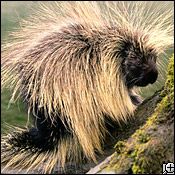When threatened, a porcupine turns away from its attacker and erects the quills on its back; upright, they detach easily if they are touched (or bitten).
The porcupine may also back up and swing its tail for additional force.
Advertisement
These solitary nocturnal creatures feed on leaves, berries, roots, seeds, twigs, and bark.
Adept climbers, they ascend trees for food, to escape predators, and to sleep.
The female's estrus lasts from eight to twelve hours and the normally sedentary male searches for her by her smell.
Their courtship is accompanied by loud screeches, and the male mounts her carefully from behind, a mating position adopted by most mammals.
Advertisement
